Basketball Offense - Dick Bennett's Blocker Mover Offense
By Dr. James Gels, From the Coach’s Clipboard Basketball Playbook"Helping coaches coach better..."
Disclosure: This page contains affiliate links, which means that Coach's Clipboard receives a small commission (at no cost to you) if you make a purchase using these links.
The Blocker Mover offense was developed by legendary coach Dick Bennett at University of Wisconsin Green Bay and then Washington State University. The offense gradually evolved over the years under Coach Bennett. His son, coach Tony Bennett, uses it a University of Virginia. It's predicated on the reality that not all players are natural scorers and ball-handlers, and we want to get shots for our best shooters/scorers.
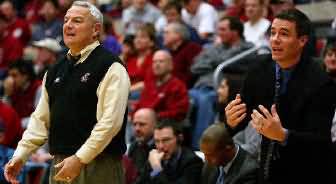
Coaches Dick and Tony Bennett
Movers are primarily scorers. They play all over the court, from side to side and top to bottom. A mover looks for a "blocker" to get a screen, then uses the screen correctly, reads the defense and makes the right cut.
For example, if his defender chases around the screen, he will curl cut. If the defender goes under the screen, he will flare cut. A mover might also screen, although his/her primary thought is to find scoring opportunities.
https://www.championshipproductions.com/cgi-bin/champ/p/Basketball/Lute-Olson-1-1-3-and-1-3-1-Match-Up-Zone-Defenses_BD-02277.html?mv_pc=jgelsmd https://www.championshipproductions.com/cgi-bin/champ/p/Basketball/The-BlockerMover-Offensive-System_BD-03004.html?mv_pc=jgelsmd Blockers are smart team players who embrace their primary responsibility of setting good screens for movers. After screening, a blocker may set another screen, or in reading the defense, may shape up to the ball or slip the screen for a pass inside and a lay-up.
Blockers score inside off posting up, slipping screens, offensive rebounding, etc. Blockers are restricted to operating in just certain areas of the floor (discussed more below). After screening, a blocker might pop outside for a pass to help relieve pressure, or to help with ball-reversal.
There are variations of the blocker mover offense. Some coaches use three blockers (two "free blockers" and one "lane blocker") and two movers. We'll discuss coach Dick Bennett's Blocker Mover offense, which uses two blockers and three movers.
In teaching the offense, Coach Bennett believes in teaching it "as a whole", 5-on-5, and does not use breakdown drills per se. In running this offense, blockers must learn how to become good screeners, and movers must learn how to use screens correctly, and how come off those screens and make shots.
So, yes, you will use breakdown drills to teach those basic offensive fundamentals and you will use shooting drills with shooters coming off screens. But in teaching and learning the offense, go 5-on-5.
Three of Coach Bennett's Offensive Concepts
- Side-Top-Side Mentality.
Defenses tend to breakdown with ball-reversal. Look to pass the ball from the top, to a side, back to the top, and to the other side.
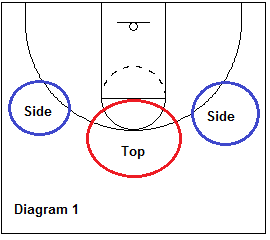
- Be deliberate when the ball is on the top, and quick with the ball on the sides (wings). When the ball is on the top, the perimeter player should pause and look inside for a cutter or a post-up, and allow time for the helpside defenders to clear out (no helpside when the ball is on the top).
When the ball is on the side (wing), the defense has to scramble into helpside, and we want to pass and move quickly before they get there. The longer you hold the ball on the wing, the more time you allow the helpside defense to get set. - Your personnel.
Determine who are your blockers and who are your movers and set their roles.
Four Basic Sets
Coach Bennett has used any of these four basic sets:- Lane-Lane set
- Wide-Wide set
- Lane-Wide set
- Top-Bottom set
Lane-Lane Set
This set uses two inside post, or "lane", blockers, and looks like a 3-out, 2-in offense. Each blocker stays on his side of the floor (no crossing over), and sets screens up and down the lane line. Diagram 2 shows O5 patrolling the left lane line, while O4 operates along the right lane line. A lane blocker (diagram 3) looks to pin and seal defenders inside and shape up to the ball (post-up).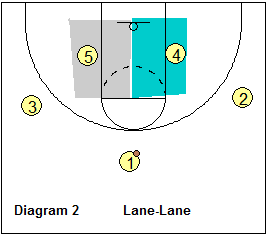
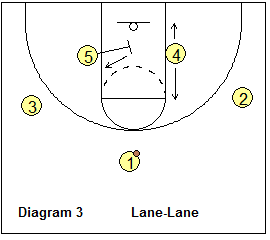
This set features multiple staggered screens. Although nothing is scripted in the Blocker Mover offense, the diagrams below show some typical actions. In diagram 4, mover O2 uses baseline screens from O4 and O5, and looks for the pass from O3 for a shot. After screening, O5 posts-up. In diagram 5, a mover O3 also goes inside and screens and we now have a triple staggered screen for O2. Movers might also start low and curl around screens from our blockers.
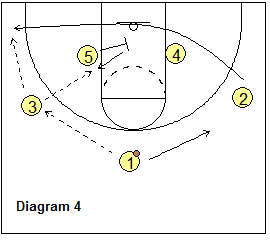
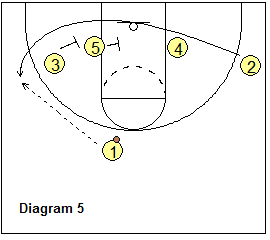
Wide-Wide Set
With the wide-wide set, two "wide" blockers are used, each having complete freedom to set screens anywhere on their side of the floor from the lane to the sideline and up to the arc. After screening, the blocker might screen again, or open up to the ball for a pass and shot. A wide blocker is usually more involved as a scorer than a lane blocker. Back-cuts are often open.The next series of diagrams shows some examples of screening action. Again, nothing is scripted. It's all free-lance. Diagram 7 shows a baseline screen and a curl cut.
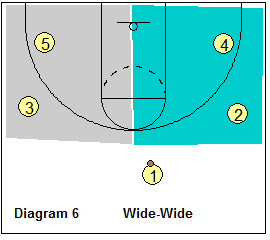
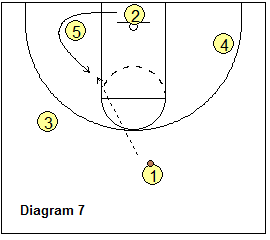
Diagram 8 shows blocker O4 setting a flare screen for O1. O4 could also slip this screen and basket-cut, or could delay and then cut down the lane for a pass from O1. Elbow screens are good too.
Diagram 9 shows blocker O5 setting a back-screen for O3, and the back-cut action. After screening, O5 might pop out to the arc briefly.
Diagram 10 shows O4 setting a ball-screen for O2, and we have a pick and roll (or pick and pop) situation.
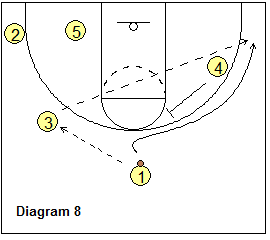
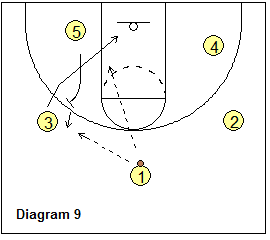
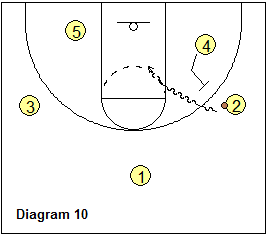
Two additional sets - Lane-Wide Set and Top-Bottom Set - are discussed in the Premium Members section
In summary...
Coach Dick Bennett's Blocker Mover offense is a true, unscripted motion offense with numerous screening and cutting opportunities. There is constant motion and there should be no standing around on offense.It tends to be a deliberate offense as players must be patient, waiting for opportunities to develop. Defenders often get tired calling out and fighting through screens. Your offense will usually improve throughout the season as players become better at seeing and seeking the opportunities and reading the defense.
See the complete article in the members section.
Sign up now!
The complete article also includes:
- Lane-Wide Set
- Top-Bottom Set
Related page:
